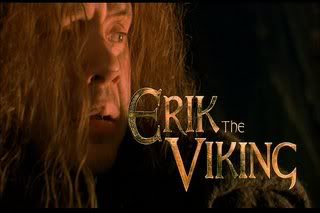
When I was but a lad, I was lucky enough to get a copy of Terry Jones’ Erik the Viking (1989) by taping it off of Super Channel when they were running a free preview month. The video quality was sketchy, and the beginning and ending were missing, but I watched that damn tape until it nearly disintegrated. Erik the Viking had everything, as a kid, that I wanted in a film--swords, violence, magic, and humour. Turns out, upon viewing Erik the Viking: The Director’s Son’s Cut (2007), that this is almost exactly what I want in a film as an adult. A journey of magic and wonder, Erik the Viking is like Monty Python doing The Seven Voyages of Sinbad the Sailor (OK, I know, wrong country, wrong period--but still, I maintain, the description fits!).
It starts with an unlikely situation for a comedy: Erik’s (Tim Robbins) attempted rape of Helga (Samantha Bond). Erik is unable to complete this routine Viking task, since he’d prefer that the two develop a loving relationship before proceeding any further. He’s not, it would seem, a very good Viking. In the following moments, Helga is accidentally killed, and Erik, in turn, decides that he will enlist his fellow Vikings in a journey to Valhalla, where he will end Ragnarök, make Fenrir the wolf cough up the sun, and hopefully bring Helga back to life in the process. His Viking friends--chief among them the fearless warrior Thorfinn Skullsplitter (Richard Ridings) and Sven the Berserk (Tim McInnerny)--agree to follow Erik, if only because to refuse might be seen as a sign of weakness.
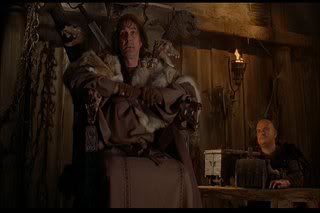
“You don’t go through all the hardships of an ocean voyage to make friends!” Thorfinn Skullsplitter tells our hero, Erik, with a large degree of contempt, and in doing so illustrates the major differences between Erik and his Viking brethren--Erik is, for the most part, a nice guy. With his belief in love and selfless action, he sticks out like a sore thumb amid his brutal kinsmen, and former Python member Terry Jones knows how to play this intrinsically comedic situation for some hearty laughs. In fact, on close inspection, it turns out that Erik the Viking is set up like a series of sketches: it’s Sven’s argument with his dad over what it means to be a berserk, followed by Erik’s pitifully bad goodbye speech, followed by the chaotic tussle with the Dragon of the North Sea… Each comedic set-piece fits perfectly into the overall story, so that the narrative never seems herky-jerky, and most of these scenarios provide a good laugh.
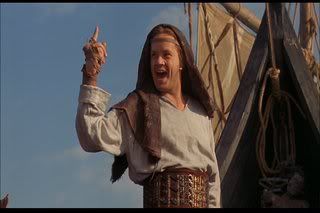 Much of the film’s strength comes from Erik’s shipmates. My favourites among them are Sven and Sven’s Dad; the latter of which is constantly lecturing his son on how to properly be a berserk (“You must only let the red rage take hold of you in the thick of battle!”), which inevitably leads to Sven loosing his cool and, in doing so, disappointing his father. Freddie Jones is suitably hilarious as the hapless Christian missionary, John Gordon Sinclair lightens up all the scenes he’s in as the cowardly drummer, Ivar the Boneless. Jones’ old Python compatriot, John Cleese, is cast as the villain of the piece, Halfdan the Black. Much like the character of Erik is made funny by contrasting his personality (kind and caring) with his occupation (marauding Viking), Cleese’s Halfdan turns out to be, rather humorously, a fairly well-mannered despot.
Much of the film’s strength comes from Erik’s shipmates. My favourites among them are Sven and Sven’s Dad; the latter of which is constantly lecturing his son on how to properly be a berserk (“You must only let the red rage take hold of you in the thick of battle!”), which inevitably leads to Sven loosing his cool and, in doing so, disappointing his father. Freddie Jones is suitably hilarious as the hapless Christian missionary, John Gordon Sinclair lightens up all the scenes he’s in as the cowardly drummer, Ivar the Boneless. Jones’ old Python compatriot, John Cleese, is cast as the villain of the piece, Halfdan the Black. Much like the character of Erik is made funny by contrasting his personality (kind and caring) with his occupation (marauding Viking), Cleese’s Halfdan turns out to be, rather humorously, a fairly well-mannered despot.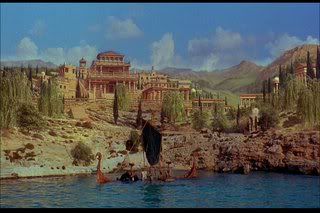 It’s hard to imagine a movie like Erik the Viking being made by anyone else--save, of course, another Python alum, Terry Gilliam. Jones, who has a degree in Modern History from Oxford, had already cut his teeth as a director in the Python vehicles Holy Grail and Life of Brian. In those films, as in Erik the Viking, you can see that Jones is every bit as interest in depicting the gritty, stinky details of the historical period, as he is in revelling in its absurdities. Certainly he does not attempt a faithful recreation of the period, but his historian’s eye for detail helps him craft a world that feels suitably authentic--and that makes it all the more funny.
It’s hard to imagine a movie like Erik the Viking being made by anyone else--save, of course, another Python alum, Terry Gilliam. Jones, who has a degree in Modern History from Oxford, had already cut his teeth as a director in the Python vehicles Holy Grail and Life of Brian. In those films, as in Erik the Viking, you can see that Jones is every bit as interest in depicting the gritty, stinky details of the historical period, as he is in revelling in its absurdities. Certainly he does not attempt a faithful recreation of the period, but his historian’s eye for detail helps him craft a world that feels suitably authentic--and that makes it all the more funny.Unfortunately, the only version of Erik the Viking available on DVD is The Director’s Son’s Cut. This new cut reorders a scene or two, but most of the editing involves “trimming” each scene. Most noticeable, however, is some audio editing, which involves some audio close-ups of special effects sounds which end up being really distracting (the “roaring” during the battle with Halfdan the Black is the most obvious--and painful). The ending suffers the most, with the last few scenes racing along, and the cutting from scene-to-scene becoming disjointed. This anemic cut of Erik the Viking comes with a reasonable amount of extras, including a behind-the-scenes look at the making of The Director’s Son’s Cut, which leaves the viewer with the (probably correct) impression that the director’s son has no idea what he’s doing.
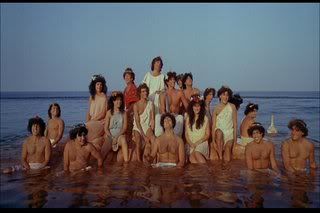 The changes made in The Director’s Son’s Cut are not all bad--it speeds up the middle of the film nicely (even though humour sometimes needs those extra few seconds to really pay off)--but on the whole I think they’re probably detrimental to the film. That being said, it’s the only version available on DVD, so you’d be foolish to pass it up just because of the editing. Erik the Viking: The Director’s Son’s Cut is highly recommended to anyone who enjoys Pythonesque humour, or fans of Vikings.
The changes made in The Director’s Son’s Cut are not all bad--it speeds up the middle of the film nicely (even though humour sometimes needs those extra few seconds to really pay off)--but on the whole I think they’re probably detrimental to the film. That being said, it’s the only version available on DVD, so you’d be foolish to pass it up just because of the editing. Erik the Viking: The Director’s Son’s Cut is highly recommended to anyone who enjoys Pythonesque humour, or fans of Vikings.









No comments:
Post a Comment